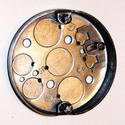Electrical Codes for Junction Boxes

|
Summary:
Listing of electrical codes for junction boxes with examples of electrical junction boxes codes for home electrical wiring.
© By: Dave Rongey |
Electrical Code Definitions for Home Electrical Junction Boxes
NEC 314.16 Wiring Methods Junction Box Fill
The volume of electrical boxes shall be sufficient for the number of conductors, devices, and cable clamps contained within the box. Code Adoption Information: The codes shown are examples only and may not be current or accurate for your application or jurisdiction. Contact your local building authority for complete information.
Nonmetallic boxes are marked with their cubic inch capacity.
Use the following table to calculate the minimum box size:
Conductor Size................................14 AWG........12 AWG
Each separate insulated wire..............2 in-3............2.25 in-3
All ground wires (combined)................2 in-3............2.25 in-3
For each device (switch/receptacle).....4 in-3............4.4 in-3
All internal cable clamps (combined)....2 in-3...........2.25 in-3
Sample Box Fill Calculation:
Four 14/2 w/ground type NMB cables:
8 insulated wires...................16 cubic inches
All ground wires......................2 cubic inches
1 switch.................................4 cubic inches
1 receptacle...........................4 cubic inches
All cable clamps (combined)....2 cubic inches
Minimum Box Volume...........28 cubic inches
NEC 370-29 Do not conceal junction boxes in walls, ceilings, or non-accessible attics and under-floor areas.Residential Electrical Code Examples for Junction Boxes
IRC Codes
Boxes: Junction, outlet, and lighting
1.Unused openings in boxes and conduit bodies shall be closed. 2003 IRC E3806.4
2.All boxes shall be accessible. NEC 314.29
3.Boxes shall be installed at each conductor splice point, outlet, switch point, junction point, or pull point. NEC 314
4.Non-metallic boxes of rectangular shape (2 1/4 inch x 4 inches) can be used in both walls and ceilings. No clamps necessary if wire is fastened within 8 inches of the box. NEC 314.17
Always contact your local building authority for complete and up to date code information.















